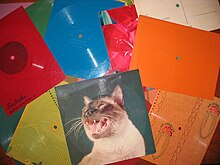Cardboard record

Acardboard record,commonly referred to as thesound postcard(Polish:pocztówka dźwiękowa) inPoland,is a type of cheaply madephonograph recordmade ofplastic-coated thinpaperboardthat was particularly popular inPolandbetween the 1960s and 1970s, but also in other regions. These discs were usually small, had poor audio quality compared to vinyl oracetatediscs, and were often only marginally playable due to their light weight, slick surface, and tendency to warp like atacoshell. Playability could be improved by placing a coin between thelock grooveand the spindle hole to add weight and stability. These records are distinct from bothflexi discs,which are sturdier, and from many of the old home-recording discs since cardboard discs were mass-produced for a specific purpose.[1]
Cardboard records were often used as freebies inpromotional campaigns,and as such were expected to be played once or twice and then thrown away. Two examples, both from the late 1980s, wereLife Cereal's"Rock Music Mystery" andMcDonald's' "Menu Song" contest, both of which were designed around audio "clues". Because of their disposable, limited-run nature, as well as their association with long-gone advertising campaigns, cardboard records can be quite collectible.
Cardboard records are also associated withphonographicrecordings included with magazines of similar subject matter.
Certain songs credited to the fictional 1960s–1970s bandthe Archieswere released as cardboard records printed directly on boxes ofbreakfast cereal.Other artists—usually with a generally younger fan base—such asthe Monkees,the Jackson 5andBobby Shermanalso had records released on the backs of cereal boxes during this time. Also there were some printed on cereal boxes, for instance, "All I Have to Do Is Dream"bythe Everly Brothers.These records, if found in pristine condition, have significant value among collectors as well.
In the past,MadMagazine inserted cardboard records of songs from its series of merchandised novelty albums in certain of theirMad Super Specialreprint magazines. One of these, for example—the mid-60s release "It's a Gas!" —featured a rhythmic belching sound (allegedly provided by the magazine's fictional mascot,Alfred E. Neuman) with a honking saxophone break played by an uncreditedKing Curtis.
References
[edit]- ^WFMU 91.1 Jersey City "http://www.wfmu.org/MACrec/"April 2010
